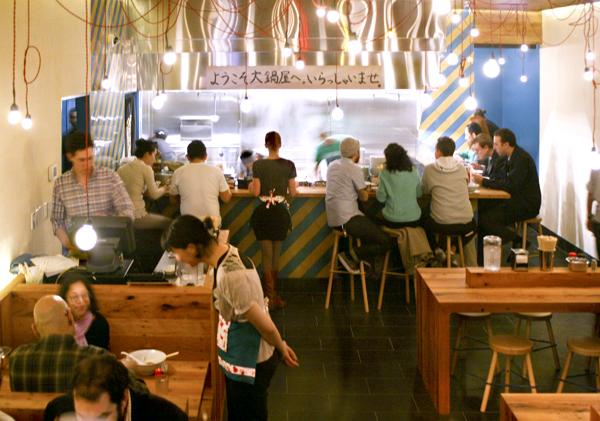Destination: Daikaya Ramen, 705 6th St. NW
The first thing that hits you when you open the door to Daikaya Ramen is the savory smell of ramen soup, accompanied by the sound of Beyoncé’s “Crazy in Love.”
The two-floor restaurant combines modern Japanese art with a more classic wooden feel to make for a cool lounge setting. Daikaya is a two-for-one experience. The downstairs floor focuses solely on ramen, and upstairs features an intimate and upscale tapas bar.
Downstairs, its traditional Sapporo-style ramen is almost a Japanese chicken noodle soup. The noodles give the soup life, while the green onions and bean sprouts give the soft ramen soup a crunchy texture. At $11.75, it is a perfect combination of Japanese flavor and comfort, with pork that melts in your mouth.
This is one of the signature dishes executive chef Katsuya Fukushima has contributed to D.C.’s authentic Japanese food scene, which he told me is relatively new to the East Coast as a whole.
Fukushima, a two-time Iron Chef winner who once defeated Bobby Flay (of just off campus establishment Bobby’s Burger Palace), has been at the forefront of the rise of the D.C. culinary scene for the past 17 years. He’s worked at several other ethnic food restaurants, but this is Fukushima’s first solo project running a kitchen, aided by his two partners, Daisuke Utagawa and Yama Jewayni.

He considers himself a “student of Ramen,” and traveled around Japan to learn how to properly recreate traditional sapporo-style ramen.
“I don’t want to stray and do crazy curry-fusion ramen,” Fukushima said. “I want to pay respect to ramen.”
Upstairs at the tapas bar, he said he draws on his culinary travels to Spain, America and Japan.
“Upstairs we do what we call ‘freestyle,’” he said, using a term from when he was a DJ and break-danced in high school and college. (Being in the kitchen hasn’t taken all of his attention away from music. He still gets to be in charge of the restaurant’s playlist.)
He also freestyles in his take on the classic sake bomb, wrapping sake in a seaweed pouch before it is dropped into the drink.
“It kind of floats in there, so as you are drinking the beer, you get the sake in your mouth and when it comes into your mouth it explodes in your mouth,” Fukushima said.
Born to a Hawaiian father and Japanese mother, he said he knows what it is like to grow up in two cultures, and uses his restaurant to explore his roots.
“The Japanese people love American culture, and they like to put spins on it. I am trying to put my spin on classic Japanese dishes,” he said.
But he also serves classic dishes, like one of his childhood favorites, an aburamiso ($3) – a savory and juicy pork miso dish in a traditional onigori rice ball, which he said his mother used to make all the time.
Fukushima’s rise has value for D.C. restaurant-goers searching for authentic Japanese food.
Takae Tsujioka, a Japanese professor in the Department of East Asian Languages and Literatures, said that you can find pure authentic Japanese food in the District, but it is difficult.
“Usually the menu is more limited in the States. It is limited to things such as noodles, tempura [and] sushi. Any ethnic food will be limited in variety,” Tsujioka said.
That’s because “Japanese chefs mold to the American palettes,” Fukushima said.
But, Fukushima added, the D.C. palette is developing an openness to his freestyling.
“It is still happening. People aren’t that familiar with Japanese food. They know sushi, tempura, and edamame, which is fine, because when I started working at Jaleo in the mid ’90s, people didn’t know tapas either,” Fukushima said.
He can now coin “Japanese Tapas” as his own.






